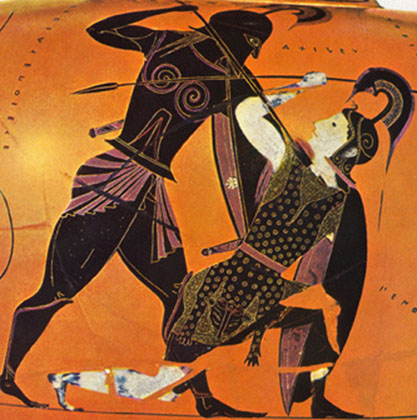Wonder-Woman, Xenu Warrior Princess, and Katniss Everdeen are today’s interpretations of Greek history’s elusive group of Amazon women. This all female tribe is usually associated with violence, war, infanticide, mutilation, and overall aggressive ruthlessness. People claim that the Amazons removed one of their breasts for more effective archery, killed any male sons, and were all homosexual because of their deep hatred for men. These legends have led the public to believe that Amazons are a myth. However, archaeologists today are finding more and more evidence suggesting the existence of “Amazons,” who are far different from their monstrous reputation.
Now to separate fact from myth: although the fantastical image of a wild tribe of women has proven to be just that, there is real evidence of ancient women exemplifying Amazonian traits. Recent excavations of Scythian kurgans (burial mounds of the nomadic Scythe population) have found female remains buried in the same fashion as warrior men–with bows, knives, daggers, tools, and hemp-smoking kits. Just like the men, their remains had war injuries. This was not a marginality either; in fact one third of Scythian women were buried this way. These findings deconstruct the idea of male burials. Rather, this ceremonial type of grave was that of an ungendered warrior. Although Amazons may not have been their own separate force, there were certainly women of Amazonian character that fought alongside men. Such rules out the origin of their respective warfare to be in reproduction, one of the four main causes for war along with territory, status, and nationalism.

The striped legs of this female warrior show her wearing trousers, which were invented for riding horses and were uncommon amongst both men and women at the time.
Scythian warrior women had a strong bond of sisterhood, which although never suggested in antiquity, were today assumed to be lesbians. This may have been true based on the Greeks’ comfort with homosexuality. Still, evidence suggests they were not regarded as lesbians, but man-lovers.
Depictions Amazon-esque women in pottery sanctified them as symbol of beauty, courage, strength, and war-spirit. In the 1300 images of Amazonian battles found in Adrienne Mayor’s studies of the infamous women, only two or three of them show signs of gesturing for mercy. They were horsebacked, arrow shooting heroes.

This image shows Amazon queen Penthesileia killing an inferior male warrior
With all of these suggestions of power, beauty, and greatness, why do we have such a negative, malicious view of the Amazons? I believe this to be a result of one of the pitfalls of archaeology: that it can reflect our present ideologies more than the past. Historically, women haven’t been viewed as valiant. We usually don’t teach history of women fighting under a male alias, or leading troops. Because the notion of heroic warrior women in our culture is so unheard of, it’s easy to rationalize the idea by dehumanizing these women. In androcentric interpretations of archaeology, it would seem more feasible for there to be crazy, animal-like lesbians on the loose than accept the fact that women may have been just as valuable and honored as men in wartime. It’s time to use proper feminist archaeology to rethink past gender roles so that we can celebrate Scythian warrior women rather than vilifying them.
Sources:
Article: http://news.nationalgeographic.com/news/2014/10/141029-amazons-scythians-hunger-games-herodotus-ice-princess-tattoo-cannabis/
Images:
Image one: http://www.beazley.ox.ac.uk/dictionary/Dict/image/amazon2.jpg
Image two: http://www.beazley.ox.ac.uk/dictionary/Dict/image/penthesileia3.jpg
Interested in more about the Scythian warriors like the Amazons? Of course you are:
http://listverse.com/2010/01/05/top-10-interesting-facts-about-the-scythians/
http://www.ancient-origins.net/myths-legends/tattooed-scythian-warriors-descendants-amazons-part-one-001155

Feminist archaeology allows us to rethink gender roles in both the past and the present. While malicious views and ideologies evident today frequently impact perceptions of history, archaeological research can also help change such harmful understandings. As one examines the Amazons from a feminist perspective, this research simultaneously contributes to and develops this perspective by revealing a history of valiant warrior women. The past does not unilaterally inform the present and the present does not unilaterally inform the past. Rather, they both interact and inform one another.